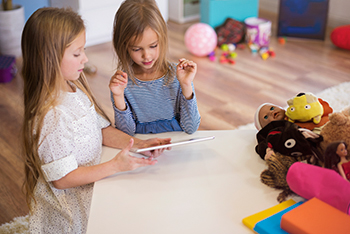Childcare centres need to follow new guidelines while also trying to resume operations to be as normal as possible. However, something important centres need to think about is the use of toys and other activities. While it may have been okay to use before, some toys now should not be used as they cannot be cleaned or are harder to clean. Now, centres need to think about ways to promote hands-on play while staying safe. Below is a list of toys and activities that are unsafe and safe for centres to use during operation.
Unsafe Toys
1. Stuffed and Plush Toys
Stuffed and plush toys, such as stuffed animals, can be difficult to clean on the daily. It needs to be washed in a washing machine for the contaminants to be removed. Offering other options, such as plastic toys, are better as it can be cleaned much quicker with sanitizing liquids.
2. Group sensory bins
Having multiple children touch the same toys in sensory bins is very risky and can spread germs quickly. Even if each child were to wash their hands before and after using these bins, there is still the risk of spread. A better option is for children to each have their own sensory bin so that they do not have to sacrifice playing with their favourite items and can still further their hands-on learning.
3. Cardboard activities
Cardboard activities, like puzzles, can be cleaned, but it is a hard process to sanitize them. The cardboard may also start to fall apart after frequent sanitization. Instead, centres can offer the same activities in plastic form as this material will not break apart after constant cleaning.
4. Shareable Computer
Computers and other shareable technology are commonly known to house a lot of germs and bacteria. Frequently cleaning these electronic devices may be doable. However, there is still the risk that some germs may remain and the devices may be damaged. If possible, an alternative solution is for centres to have more than one computer or to limit the number of children who use it daily.
5. Sand and Water Tables
Having group sand and water tables that are although fun for children to play with, are a hassle to keep clean. After each use, the sand and water would need to be replaced so that germs won’t be spread. This can be timely so having individual bins for each child would be a more efficient and safer option.
6. Costumes
Costumes are a great way for children to express themselves and to play pretend. But it can be a hassle to wash after every single use. After each child wears a costume, it would need to be taken away so that other children can’t use it, further limiting the options they have. A more feasible option to offer are individual items, such as hats, that each child can have and keep. Doing so minimizes the spread of germs between children and allows children to still play with costume-like items.
Safe Toys
1. Blocks
The best thing about blocks is that it can come in multiple materials, like foam, wood, and plastic. Children can still have the option to use blocks as long as centres are able to divide the blocks for each child or have specific spaces around the classroom for a fixed set of blocks. Then after each use, the blocks can be laid out and sprayed down for sanitization.
2. Individual Sensory Bins
Unlike stuffed toys, sensory bins should remain in centres as they are key to furthering a child’s hands-on learning. While group sensory bins should not be available, having individual bins for each child is a great option. Centres should make sure the bins are large enough to house multiple toys and mediums so that each child can still have fun. These bins should be cleaned weekly or monthly. But if a child or someone in the centre is exposed to COVID-19, then everything should be changed and cleaned out immediately.
3. Magnets
Similar to blocks, magnets are a fun toy for children to use and can be easily wiped down after each use. Centres will just need to make sure that only a few children can use them at a time and that they are apart from each other.
4. Balls
Balls are great toys to use since there are many uses for them, such as kicking and throwing them. Plus, most balls are made of materials that can be easily and quickly sanitized.
5. Markers and other Art Supplies
A common activity that many children love is to draw and paint. It allows them to be creative and express themselves in various means. Centres just have to keep in mind to clean each supply after use or consider providing a fixed set of supplies to each child. Furthermore, a great tip for centres is to purchase clipboards (plastic, of course) so that children can draw and colour in multiple areas of the classroom while still maintaining social distancing.
Although there are multiple toys and activities that children are unable to use now due to COVID-19, there are still an abundance of other options available to assist children with their learning and growth. Teachers and providers will need to think outside-of-the-box to meet these childcare needs.
